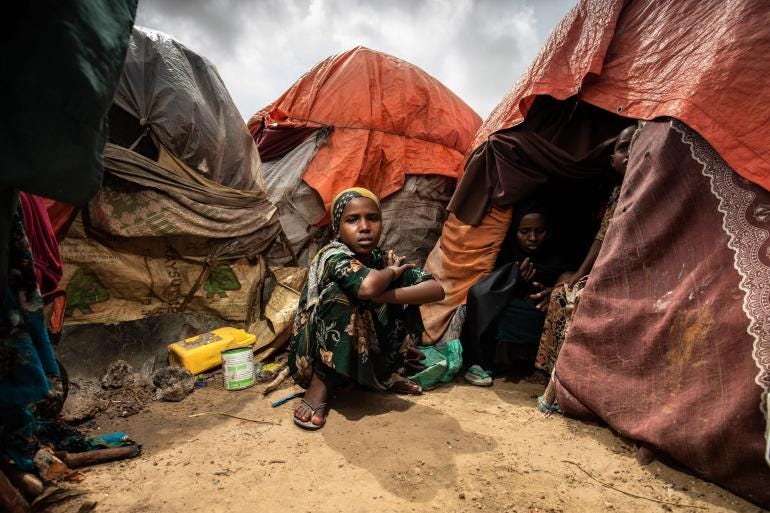Headlines from a Warming World no 6
Emergence of Extreme Wet Heat; Heat in South America Linked to Human-Caused Climate Change; Drought in the Amazon; Child Displacement by Climate Disasters; The Inevitable Energy Transition;
The Emergence of Extreme Wet Heat
Sobering new research on the places that could become ‘unlivable’ as the Earth warms. The findings suggest that a significant portion of the world’s population will experience—for the first time in human history—prolonged exposures to extreme wet heat.
In a warmer world, humans will find it difficult to adapt since these conditions will pose significant problems for the security of food, energy, and water, as well as for "human health and economic development, including in the world’s most populous and most vulnerable regions."
Wet-bulb temperature (WBT) measures the effects of heat stress on people by combining dry air temperature (as displayed on a thermometer) and humidity. A wet-bulb temperature (TW) of 35°C marks our upper physiological limit. However, according to the scientists on the paper, recent empirical research using human subjects found that even with minimal metabolic activity, the maximum wet-bulb temperature (Tw) at which the human body can maintain its core temperature through sweating—i.e., thermoregulation—is lower than previously thought. This could have significant implications for our understanding of how climate change might impact human health and habitability in certain regions.
Source: Daniel J. Vecellio, W. Larry Kenney, and Matthew Huber, Greatly enhanced risk to humans as a consequence of empirically determined lower moist heat stress tolerance, PNAS, October 9, 2023, https://doi.org/10.1073/pnas.2305427120
Unprecedented Heat in South America Linked to Human-Caused Climate Change
The extreme late winter and early spring heat in large parts of South America—central and northern Brazil experienced temperatures above 40°C in mid-September—would have been virtually impossible in a world without human-caused climate change.
A World Weather Attribution study found that climate change made the prolonged heat at least 100 times more likely and 1.4–4.3ºC hotter.
"With future global warming, heat events like this will become even more common and hotter. At global mean temperatures of 2°C above pre-industrial levels, a heat event like this would be about another 5 times more likely and 1.1 to 1.6 °C hotter than today."
Unprecedented Drought Hits Amazon Rainforest
The Amazon rainforest in Brazil is currently facing an unprecedented drought, the worst in over 121 years. This extreme weather event has caused the water level at a major river port to plummet to its lowest recorded point, leading to significant disruptions in the lives of hundreds of thousands of people and causing extensive damage to the jungle ecosystem.
The epicentre of this crisis is the port in Manaus, the region's most populous city, strategically located at the confluence of the Negro and Amazon rivers. The water level at this port was recently recorded at 13.59 meters, a record low since measurements began in 1902. This drastic reduction in water levels has led to the rapid drying of tributaries feeding into the Amazon River. As a result, boats have been stranded, and essential supplies of food and water to remote jungle villages have been cut off.
In addition to the water scarcity, the drought has also led to a spike in water temperatures, which are suspected to have caused the deaths of more than 100 endangered river dolphins. The water temperature in Lake Tefé, for instance, reached a staggering 39 degrees Celsius at the end of September, significantly higher than the usual temperature. These high temperatures can disorient the dolphins, causing them to swim in circles until they eventually die from oxygen deprivation.
The Brazilian government has attributed this severe drought to the onset of the El Niño climate phenomenon, which is known for driving extreme weather patterns across the globe. According to the Brazilian government's disaster alert centre, Cemaden, some areas of the Amazon have experienced the lowest rainfall from July to September since 1980.
The drought is also accelerating the degradation of the Amazon rainforest. The forest itself generates up to 50% of the rainfall in the Amazon through a process where moisture is recycled from the trees back into the atmosphere. However, during severe droughts, the forest loses more water to evaporation than it receives from rainfall, leading to the death of trees. As the forest loses more trees and dries up, parts of the Amazon are rapidly approaching a tipping point, beyond which they will transition into a degraded savanna-like ecosystem with few to no trees.
The situation is expected to worsen in the coming weeks, highlighting the urgent need for effective climate action to mitigate the impacts of such extreme weather events and protect the Amazon rainforest.
Sources:
https://www.theguardian.com/world/2023/oct/16/amazon-drought-manaus-lowest-water-level
https://news.mongabay.com/2022/09/more-droughts-are-coming-and-the-amazon-isnt-ready-study/
Child Displacement by Climate Disasters
According to a recent report by UNICEF, extreme weather events and climate disasters have displaced more than 43 million children globally from 2016 to 2021. This displacement is equivalent to approximately 20,000 child displacements a day.
These disasters, fueled by climate change, range from floods to droughts, to storms and wildfires. Floods and storms accounted for 95% of recorded child displacement during this period. Wildfires and drought displaced the rest.
“According to the analysis, China and the Philippines are among the countries that recorded the highest absolute numbers of child displacements, due to their exposure to extreme weather, large child populations, and progress made on early warning and evacuation capacities. However, relative to the size of the child population, children living in small island states, such as Dominica and Vanuatu, were most affected by storms, while children in Somalia and South Sudan were most affected by floods.”

Apart from the psychological stress and education disruption, children who are displaced due to extreme weather events face several risks, including increased poverty, health risks due to inadequate access to food, clean water, sanitation, and healthcare services, as well as exploitation, abuse, and violence.
The report underscores the urgent need for global action on climate change, as its impacts pose severe risks to the world’s most vulnerable populations, especially children.
Climate change is not a distant problem but a clear and present danger that’s already having profound impacts on human lives and communities.
The Inevitable Energy Transition
The global coal industry is predicted to lose nearly 1 million jobs by 2050 due to the transition towards cleaner, low-carbon sources, with China and India facing the biggest losses.
The need for a transition away from coal mining is both inevitable and compelling. Coal mining is responsible for significant environmental, societal, and health impacts such as air and water pollution, habitat destruction, soil erosion, climate change, and community displacement. To safeguard our planet's and communities' welfare, we must shift away from coal mining. However, it requires collaboration between governments and industries to prevent workers and communities from suffering.
Plastic Pollution
Microplastics have been found everywhere, in every nook and cranny of the planet, including oceans, rivers, and even the air we breathe. They have been detected in multiple organs, such as the lung, heart, blood, placenta, and faeces. They measure less than 5mm in size and are the result of the breakdown of larger plastic items like bottles and bags.
Now, Japanese scientists have found microplastics in the clouds.
“Ten million tons of these plastic bits end up in the ocean, released with the ocean spray, and find their way into the atmosphere. This implies that microplastics may have become an essential component of clouds, contaminating nearly everything we eat and drink via ‘plastic rainfall.’”
The plague of disposable coffee cups
And something different from the subjects you usually read here. Killarney is a tourist town in the county of Kerry, Ireland. The price of being a popular tourist destination was the ubiquitous disposable coffee cups spilling from bins, littering roads, and blighting the area’s national park. The number is staggering: 23,000 cups a week—more than a million a year—adding up to 18.5 tonnes of waste.
Not anymore. Three months ago, Killarney became the first town in Ireland to phase out single-use coffee cups. If you want a takeaway coffee from a cafe or hotel, you must bring your own cup or pay a €2 deposit for a reusable cup that is returned when the cup is given back.
Well done to the three individuals—Louise Byrne, left, Ciara Treacy, and Killian Treacy—who have led Killarney’s scheme against single-use coffee cups. I wish many more people, towns and cities would follow and implement similar sustainable practices. By doing so, we can create a more environmentally conscious society that prioritises the well-being of both its residents and the planet. Additionally, widespread adoption of these initiatives can lead to a positive ripple effect, inspiring other communities to take action and collectively work towards a greener future.








